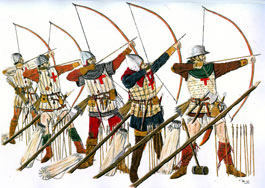
Longbow archersH I S T O R Y
An army of generous contributors
Getting to know the longbow through history
To fully discover the unique characteristics of the longbow and link the sport of today with the weapon of the past, makes history an indispensable ally. The longbow was the artillery of the Middle-Ages. It was mobile, light and flexible. The reach of the longbow men was considerable and the penetrating power of their weapons renowned. The adversary was caught in a hail of arrows before closing in.
In a pre-industrial age the bow was quick to make in large numbers. Its arrows were produced and carried in millions. However, the longbow was essentially a defensive weapon. Features of the chosen terrain of battle were often critical. The longbow men were vulnerable if not protected by stakes, ditches, potholes and/or caltrops. Their success depended on circumstances whereby they could bring about concentrated shot in volleys of arrows.
Six battles of the 100-year war re-balance an over-enthusiastic belief in the invincibility of the longbow. Its strengths and weakness are well illustrated by the different outcome of each confrontation. In crushing victories at Crécy, Poitiers and Agincourt the brave, resourceful and disciplined English armies wrought havoc against overwhelming numbers. Then bloodied by experience the French cavalry rode down the longbows at Patay, turned their flank at Formigny, before wining the day in the battle of Castillon where it allied the raw courage and élan of its cavalry to the ingenuity of a command-structure adapted to a new weapon; gunfire.
History is about a truthful and balanced account of the facts and circumstances. That together with continued informed debate make it essential that the academic rigour of historians who have done years of painstaking research, the hands-on knowledge of the longbow men of today and the inspiration derived from visiting the battle-sites themselves should each be given their due. The quick enthusiastic and discerning contributions from each of the following were and remain indispensable to this process and are gratefully acknowledged:
Professor Anne Curry, for her balanced view of history that so eloquently combines academic rigour with detailed research  and breadth of technical knowledge.
and breadth of technical knowledge.
Dr Robert Hardy, who by sheer grit and the gift of superb delivery, honed on historical and contemporary insight as well as research, put the longbow into the public domain.
Matthew Bennett, whose experience of teaching the military offered unique insight, delivered with a quick mind honed on years of research. His remarks at this account introduced into it some of that requisite military precision.
Lt Col Alfred H Burne, for patiently contributing his expertise gained through years military service, followed by research and an intimate understanding of the battle-sites concerned. His "inherent military probability" a balanced and persuasive interpretation of a military commander.
Roy King, Pip Bickerstaffe, Neil Harrington, Richard and Philip Head and Ron Palmer and may other bowyers, for their continuing help and inspiration towards these unique shooting traditions. Men who continue to make longbows when others have come and gone. Craftsmen who have stress-tested, analysed and experimented with every type of wood, shape of bow, nock and handle, with every glue. Where King Henry’s army to nock at their door, these men would surely deliver.
Mark Stretton, Geoff Towers, Nigel Canning, Neil Harrington and others in the small circle of longbow men able to draw the heaviest bows to original specification and willing to share their expertise.
Hector Cole, for his artistry and insight as Britain’s top arrow smith. www.hectorcoleironwork.com
Paul Hitchin, for his beautiful illustrations khttp://www.warriorsfortheworkingday.com